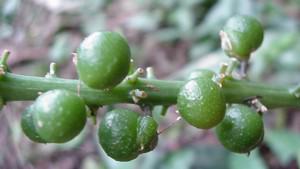Sansevieria hyacinthoides
Sansevieria hyacinthoides (L.) Druce
Family: Ruscaceae
Common names: mother-in-law’s tongue, piles root, bowstring hemp (Eng.); skoonma-se-tong, aambeiwortel, haasoor (Afr.); kai, ghaiwortel (Khoi); isikholokotho (Xhosa, Zulu); isikwendle, isitokotoko (Zulu)
Introduction
The mother-in-law’s tongue is an evergreen, perennial herb, with its handsome robust, flat, dark green and fibrous leaves that attact game. Its scented flowers also attract insects and birds to your garden.

Description
Description
Sansevieria hyacinthoides is a robust, evergreen, perennial herb, up to 600 mm high. Its rhizomes are sturdy, fibrous and bright orange. The leaves are erect, borne in pairs of 5–12 in loose clusters, arising from the ground, broadly lanceolate to ovate, flat, ± 600 × 80 mm, dark green with paler markings, and margins red.

The inflorescence is a many-flowered raceme, ± 450 mm high. The flowers are stalkless, white, cream-coloured or greenish white to pale mauve; borne in clusters, fairly scented, opening at night. Sansevieria hyacinthoides flowers in September to May. The fruit is an orange berry, ± 8 mm in diameter.

Mother-in-law’s tongue can be confused with Sansevieria metallica (giant sansevieria), which is a robust plant and grows up to 1.6 m tall. The giant sansevieria has 2 or 3 leaves, ± 1 m high, pale green with white markings and deeply channelled. Its flowers are caramel-toffee-scented. It is naturally found in sand forest of northern Kwa Zulu–Natal extending to tropical Africa.
Conservation Status
Status
According to Raimondo et al. (2009), Sansevieria hyacinthoides is Red Listed as LC (Least Concern), as evaluated against the five IUCN criteria.
Distribution and habitat
Distribution description
Sansevieria hyacinthoides occurs naturally in bushveld, among rocks in the shade of trees, in the Eastern Cape, KwaZulu-Natal, Mpumalanga, Swaziland, Limpopo Province, North-West, Botswana and Namibia. It also occurs on wooded stream banks and in kloofs.
Derivation of name and historical aspects
History
The genus Sansevieria was named after Pietro Sanseverino, Prince of Bisignano, in whose garden near Naples the plant was found growing. The specific name hyacinthoides means resembling a hyacinth.

Ecology
Ecology
The leaves of Sansevieria hyacinthoides are browsed by game such as rhinoceros and antelope. The rhizome is eaten by mole rats. The fibre from the leaves is utilised by weaver birds for building nests.

Uses
Use
Rhizomes and leaves of Sansevieria hyacinthoides are used medicinally. It is a popular medicine for the treatment of ear infection, earache and toothache. It is also used traditionally to treat multiple ailments such as haemorrhoids, ulcers, intestinal worms, stomach disorders and diarrhoea. In some cultures it is used as a protective charm. The fibre can also be used to make string.

Growing Sansevieria hyacinthoides
Grow
Sansevieria hyacinthoides is a fast grower and drought-resistant. It grows very easily, needs little attention and so therefore perfect for large gardens. Leaves are attractively coloured.
It can be mass planted between the rocks in a rockery, or as hardy ground cover. It prefers sun or partial shade, in any soil type with added compost. Water sparingly. Mother-in law’s tongue also does well in a container indoors; great care must be taken not to overwater.
It is easily propagated from seeds, cuttings or by division of large clumps.
References
- Fabian, A. & Germishuizen, G. 1997. Wild flowers of northern South Africa. Fernwood Press, Vlaeberg.
- Hutchings, A., Scott, A.H., Lewis, G. & Cunningham, A.B. 1996. Zulu medicinal plants: an inventory. University of Natal Press, Pietermaritzburg.
- Joffe, P.1993. The gardener’s guide to South African plants. Tafelberg Publishers, Cape Town.
- Neuwinger, H.D. 2000. African traditional medicine: a dictionary of plant use and applications. MedPharm, Scientific Publishers, Stuttgart.
- Pooley, E. 1998. A field guide to wild flowers Kwazulu-Natal and the eastern region. Natal Flora Publications Trust, Durban.
- Raimondo, D. et al. 2009. Red list of South African plants. Strelitzia 25. SANBI (South African National Biodiversity Institute), Pretoria.
- Retief, E. & Herman, P.P.J. 1997. Plants of the northern provinces of South Africa: keys and diagnostic characters. Strelitzia 6. National Botanical Institute, Pretoria.
- Van Wyk, B.-E. & Gericke, N. 2000. People's plants . Briza Publications, Pretoria.
- Van Wyk, B.-E., Van Oudtshoorn, B. & Gericke, N. 2009. Medicinal plants of South Africa, edn 2. Briza Publications, Pretoria.
Credits
M.S. Mothogoane
National Herbarium, Pretoria
January 2015
Plant Attributes:
Plant Type: Ground Cover, Perennial, Succulent
SA Distribution: Eastern Cape, KwaZulu-Natal, Limpopo, Mpumalanga, North West
Soil type: Sandy, Loam
Flowering season: Spring, Early Summer, Late Summer, Autumn
PH: Alkaline, Neutral
Flower colour: Green, White, Cream
Aspect: Full Sun, Morning Sun (Semi Shade), Afternoon Sun (Semi Shade)
Gardening skill: Easy
Special Features:
Horticultural zones









Rate this article
Article well written and informative
Rate this plant
Is this an interesting plant?
Login to add your Comment
Back to topNot registered yet? Click here to register.